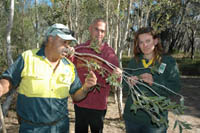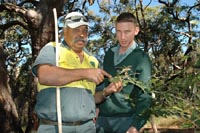Keeping tabs on the past
Note: This content is stored on an archive website and may not be current or accurate. Contact us to clarify.
Just as European society has strict rules about who people can marry to avoid close family relationships, Aboriginal elders across Australia lay down similar laws.
These rules on relationships, called “moieties”, are just part of the glimpse into Aboriginal culture that students of a Forestry Corporation, formerly State Forests, course on Aboriginal cultural awareness will see.
The courses are intended for all Forestry Corporation employees, and will be progressively delivered across the State.
Staff from North East Region from Casino, Grafton and Coffs Harbour are attending the courses.

Aboriginal cultural heritage officer Richard Kelly and Yarrawarra Aboriginal Cultural Heritage Centre officer Milton Duroux show North East Region ecology team member Anna Lloyd the significance of paperbark tree leaves
They are using the Yarrawarra Aboriginal Cultural Heritage Centre near Corindi, which is close to the Aboriginal Arrawarra fish traps and a bush tucker walk opposite the centre.
“This venue and the courses are a valuable tool in providing better understanding in the Aboriginal community of what we do, and letting our staff know of Aboriginal expectations,” Forestry Corporation North East regional manager Steve Rayson said.
The courses were prepared by Forestry Corporation Aboriginal liaison officer, Ms Cheryl Kitchener, and Aboriginal cultural heritage officers, who assist regions in pre-harvest inspections for Aboriginal and European sites of significance.
North East Region Aboriginal cultural heritage officers Robyne Bancroft and Richard Kelly have been delivering the courses.

Aboriginal cultural heritage officer Richard Kelly with North East Region Casino ecologist Ken McCray
“These courses are not designed to make people feel guilty, or to adopt a paternalistic view of the situation that Aboriginal people have endured in the past as well as the present,” Robyne said.
“They have been designed to make staff, contractors and consultants aware of, and to gain a better understanding of, the current situation that affects Aboriginal people, which has arisen since non-Aboriginal contact.”
Course coordinators use various tools to demonstrate the complicated links that affect how Aboriginal culture operates.
Their birth dictates such things as totems, which link their lives with responsibility to preserve parts of the environment such as plants and animals.
“If you are the totem of the possum, then you are not permitted to eat that food,” Richard Kelly explains.
“It is your job to make sure that possums are looked after and are not exploited, so that they will be there forever.”
The moieties make sure that cousins do not marry, so preserving the health and well being of the tribal structure.
In Aboriginal culture it is the grandparents who have day to day responsibility for children while the parents concentrate on the necessities of providing food and shelter.
“Grandparents are there to explain what can and can’t be eaten, to pass on the stories and to explain the laws of the land,” Richard says.
These include tales of the Dreaming and other stories that preserve Aboriginal heritage in what was essentially a culture with no written record.
Aboriginal cultural heritage officers examine forest compartments before harvest to ensure that areas of Aboriginal significance are not disturbed.
“If signs of Aboriginal activity are found, it is discussed with local Aboriginal elders and land councils, and together we decide how it should be treated,” Richard said.
“It may be preserved by marking it as a significant site, or it may be left undisturbed or undisclosed, depending on the wishes of the local people.”
Course participants are shown everyday items of Aboriginal life, and then tour a sample of local sites of significance to explain why they are important to Aboriginal people.
Media contact: Steve Rayson on 02 6652 0111.

